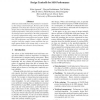Free Online Productivity Tools
i2Speak
i2Symbol
i2OCR
iTex2Img
iWeb2Print
iWeb2Shot
i2Type
iPdf2Split
iPdf2Merge
i2Bopomofo
i2Arabic
i2Style
i2Image
i2PDF
iLatex2Rtf
Sci2ools
USENIX
2008
2008
Design Tradeoffs for SSD Performance
Solid-state disks (SSDs) have the potential to revolutionize the storage system landscape. However, there is little published work about their internal organization or the design choices that SSD manufacturers face in pursuit of optimal performance. This paper presents a taxonomy of such design choices and analyzes the likely performance of various configurations using a trace-driven simulator and workload traces extracted from real systems. We find that SSD performance and lifetime is highly workloadsensitive, and that complex systems problems that normally appear higher in the storage stack, or even in distributed systems, are relevant to device firmware.
| Added | 02 Oct 2010 |
| Updated | 02 Oct 2010 |
| Type | Conference |
| Year | 2008 |
| Where | USENIX |
| Authors | Nitin Agrawal, Vijayan Prabhakaran, Ted Wobber, John D. Davis, Mark S. Manasse, Rina Panigrahy |
Comments (0)

